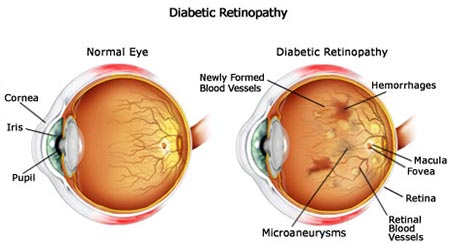
Diabetic retinopathy
Share

Diabetic retinopathy is an eye disease that can lead to loss of vision in diabetics. It has an effect on the blood vessels in the retina, which is the layer of tissue with light-sensitive in the back of your eye.
Diabetes can cause long-term or short-term eye damage.
Long term
- Long-term untreated diabetes can cause high blood sugar levels, which can eventually damage tiny blood vessels. This injury can cause issues with the retina, a component of the eye. This can result in blurred vision.
Short term
- Short-term blurriness occurs for another cause. Fluid can flow into and out of the eye of a diabetic owing to elevated blood sugar levels. This might cause the eye's lens to bulge. because the lens is the component that focuses light into the back of the eye, blurriness occurs when the shape changes. When blood sugar levels fall, this short-term problem usually resolves itself.

Diabetes can also develop blurriness in the short term if blood sugar levels go too low. Hypoglycemia is a state of low blood sugar.
In the early stages of diabetic retinopathy, you may not notice any symptoms. Diabetic retinopathy symptoms that worsen over time may include:
- Loss of vision
- Vision blurred
- Color vision impairment
- Spots or black threads may appear in your eyesight (floaters)
- Variable vision
- There are dark or empty spots in your eyesight.
Diabetic retinopathy generally affects both eyes at the same time.
Diabetic retinopathy can lead to a variety of severe eye problems, including:
Diabetic macular edema (DME).
- Approximately half of patients with diabetic retinopathy will acquire DME over time. DME occurs when blood vessels in the retina leak fluid, resulting in macula enlargement (a part of the retina). Because of the excess fluid in your macula, if you have DME, your vision will become blurred.
Detachment of the retina.
- Scars in the back of your eye might develop as a result of diabetic retinopathy. Tractional retinal detachment occurs when scars pull the retina away from the back of the eye.
Neovascular glaucoma
- Neovascular glaucoma can cause aberrant blood vessels to grow out of the retina, blocking fluid draining from the eye. This results in a form of glaucoma.

Diabetes puts you at a higher risk as a result of vision problems. Regular checks and eye examinations are essential. Every year, this should include a complete eye check up with dilation. Tell your doctor about all of your symptoms, as well as any medications you're taking. Blurred vision can be treated as a minor issue with eye drops or a new prescription for your glasses.
To purchase contact lenses, you can order online through shop.malayaoptical.com or if you just nearby Petaling Jaya area you can drop by to our shop at Malaya Optical Optometrist.
